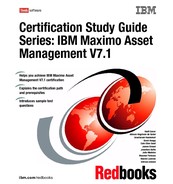Chapter 6. Purchasing 111 direct issue location. After the item has been serialized in the Receive Rotating Items dialog box, its status will be COMP. COMP ( Complete) This status indicates that the line item has been received, and if necessary, inspected and serialized. When the status of the line item changes to COMP, a transfer transaction is created. The transaction transfers the item to its appropriate storeroom or direct issue location. If the line item is not rotating and does not require inspection, its status is COMP upon receipt. 6.6.1 Rotating items A rotating item is an individual serialized asset that you define with a common item number, such as a pump or mobile computer. You designate an item as rotating because it shares properties of both items and assets. A rotating item can have inventory value and issue cost, like an item. However, a rotating item cannot be consumed, rather, it is maintained like an asset. For example, you have ten mobile computers of the same model that share the same attributes, and they all have the common item number ABCT23. However, you want to be able to track each as an individual asset, so you flag the items as rotating when you create them. After creating an item and adding it to a storeroom, you can either use the Assets application to create the asset records for an item you want to track, or create a purchase order for the rotating item and serialize it when you receive it. When you have associated an asset to a rotating item, balances can be displayed and tracked for this item. A rotating item is tracked both by its item number in Inventory records and by its unique asset number in Assets records. Each rotating item goes into Inventory with an item number. The rotating item is also tracked in the Assets application with an asset number. To enter line items for rotating items on the Material Receipts tab, use the Receive Rotating Items dialog box. You can enter asset identifiers for specific rotating assets, or auto- number all of the rotating items. Note: An item cannot be both a spare part and a rotating item, because rotating items are generally maintained not consumed ( or just used once). For example, you can keep gaskets available as spare parts for use on multiple pieces of equipment, but you cannot classify the gaskets themselves as rotating items because they are used once and then thrown away.
